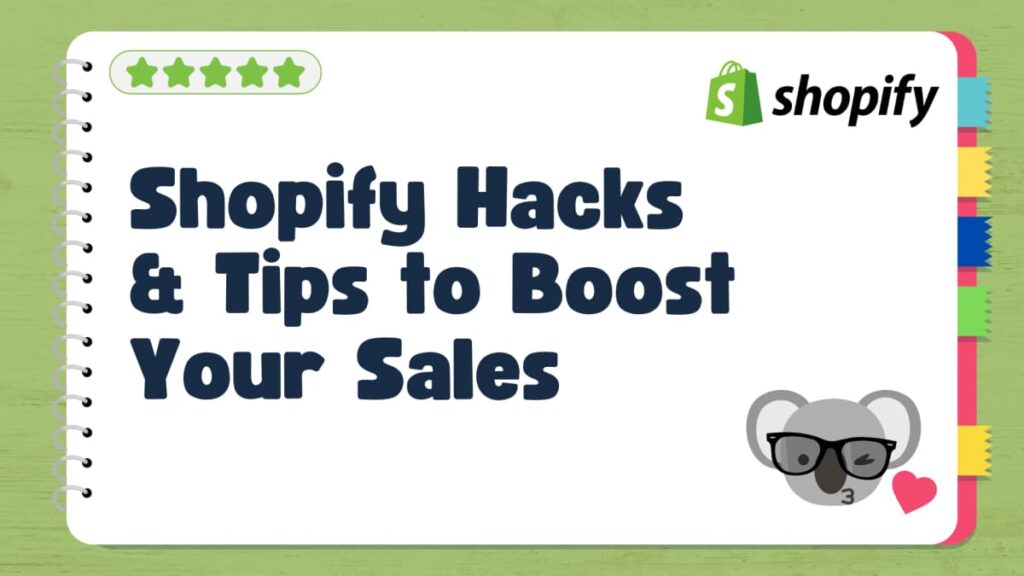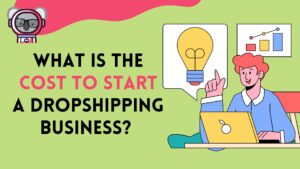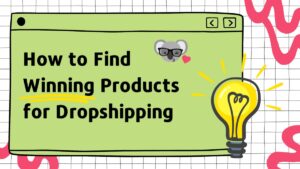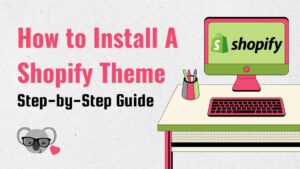So, you’ve set up your Shopify store, found your winning products, and started to make sales. You’re seeing a lot of site traffic, but business just isn’t going up no matter what you do, or you’re running out of time every day trying to keep on top of things.
Operating a profitable e-commerce business takes more than launching a few marketing campaigns and hoping for the best. E-commerce is a very competitive space, and you have to battle over customer dollars with over 4.5 million active vendors on Shopify’s platform alone.
There are a few tips and tricks to increase profit and save time – from obvious solutions like offering rewards programs and perks to more advanced strategies like API integrations.
Here are the 18 most effective Shopify hacks in 2024.
Sales & Conversion Hacks
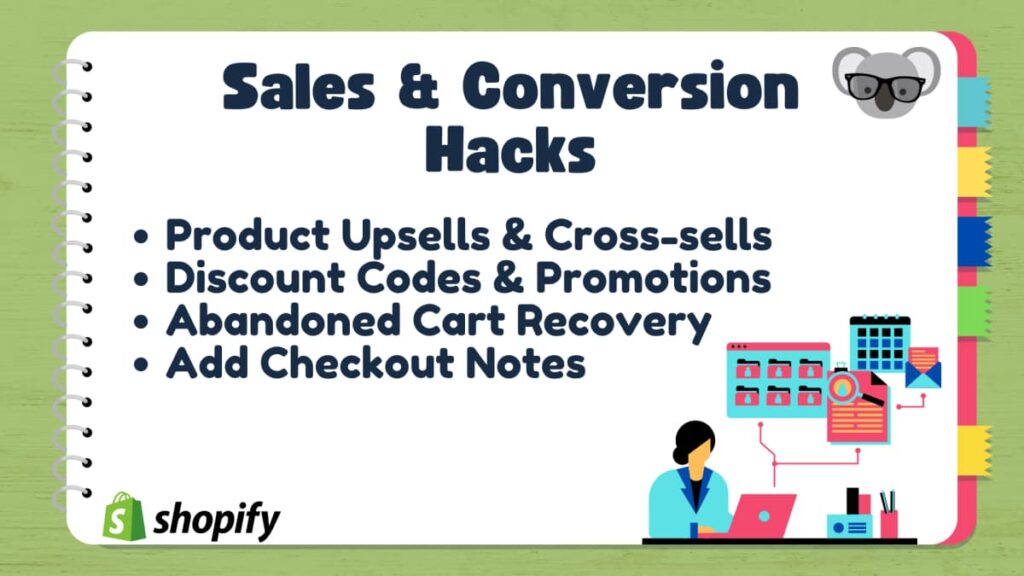
The goal of every online store is to turn website visitors into customers who gladly spend their money on the offered products. And even better if they become repeat customers.
An easy way to check your conversion rates is to divide the total number of monthly sales by the total number of monthly visitors and then multiply by 100. In an ideal world, every website visit translates into a purchase, but unfortunately, that’s not how it works.
On average, e-commerce stores can expect conversion rates of around 2.5%-3%. That said, let’s look at 5 tried and true hacks to turn a higher number of website visits into pure profit.
1. Product Upsells & Cross-sells
One obvious way to increase your margins is to give customers more shopping options before they check out. Show them what else is on offer, but don’t just place random products in front of them. Provide them with a curated selection that matches what they’re already looking at.
A few tactics you can try are:
- Bundling Products. You can group your best-sellers with other complementary items that aren’t moving as fast. Create bundles that cost more than the individual item the customers are looking at but, of course, are still worth the price.
- Offering Add-ons. During checkout, you can add a list of additional products buyers can add to their purchases. For example, if they’re buying a sports bra and leggings, display related add-ons like a pack of matching workout socks or sweatbands.
- Personalized Recommendations. Shopify collects extensive customer data. Present customers with targeted items based on their shopping interests or browsing history. Use data regarding previous purchases to customize the product recommendations.
2. Discount Codes & Promotions
Everyone loves a good deal, especially if they feel they snagged it at the last minute. Many shops run discounts and special offers, so buyers are used to them. What actually works is creating a sense of urgency and scarcity to trigger a feeling of FOMO.
The fear of missing out on an item other people are purchasing can lead 60% of consumers to buy it. Labeling certain items as having limited quantities or fast-selling increases their desirability and motivates consumers to buy while they are still in stock.
The same is true for limited-time offers. For example, a deal that gives you 20% off your second item during a set period is much more appealing than a permanent 20% discount.
Another way to increase sales is to gamify the process. Introduce loyalty programs or reward points and let buyers work their way up to exclusive perks or even free gifts when they give you repeat business. Give them access to exclusive coupons and discount codes as well, as they’ll be actively searching for them, so having a promotions section will drive traffic to your website.
3. Abandoned Cart Recovery
In e-commerce, customers who abandon their carts are the biggest contributors to revenue loss. According to a Deloitte survey, 6 in 10 consumers will abandon their cart if they need to pay shipping fees. On the other hand, 8 in 10 are willing to meet a minimum price threshold when they know it comes with no associated shipping costs.
You can potentially recover this loss by sending out automated email notifications. Remind consumers that their cart is still full and waiting. Offer free shipping or a significant discount as an incentive to finalize their purchase, as they probably left because of the cost or shopping fees. For this strategy to work, you must collect their email before checkout starts.
4. Add Checkout Notes
One small hack that has a big impact is enabling checkout notes. Even though many Shopify themes have this feature, very few users know how to activate it. The process is simple:
- Go to your Shopify admin page
- Enter your Online Store
- Press on Theme
- Click Customize
- Go to Theme Setting
- Click on Cart
- Select Enable order notes or Enable cart notes
Now, customers can add notes to their orders, asking to customize some aspects; they can ask you to add or remove a feature or even include a personalized note if buying a gift.
5. Use a Skip to Checkout Feature
Another tip is allowing buyers to skip the cart and go straight to checkout. This is especially useful if you’re selling on other platforms connected to your Shopify store.
Having a “Buy Now” button will allow consumers to buy directly from the page they are on without having to navigate through other windows. This shortens the time they spend in the sales funnel and makes it less likely they’ll change their mind and not buy.
Add this feature to hot-ticket items and pricier Shopify products that sell more individually. You can install an app like Skip to Checkout for Shopify to add this feature to your shop.
Marketing & Growth Hacks
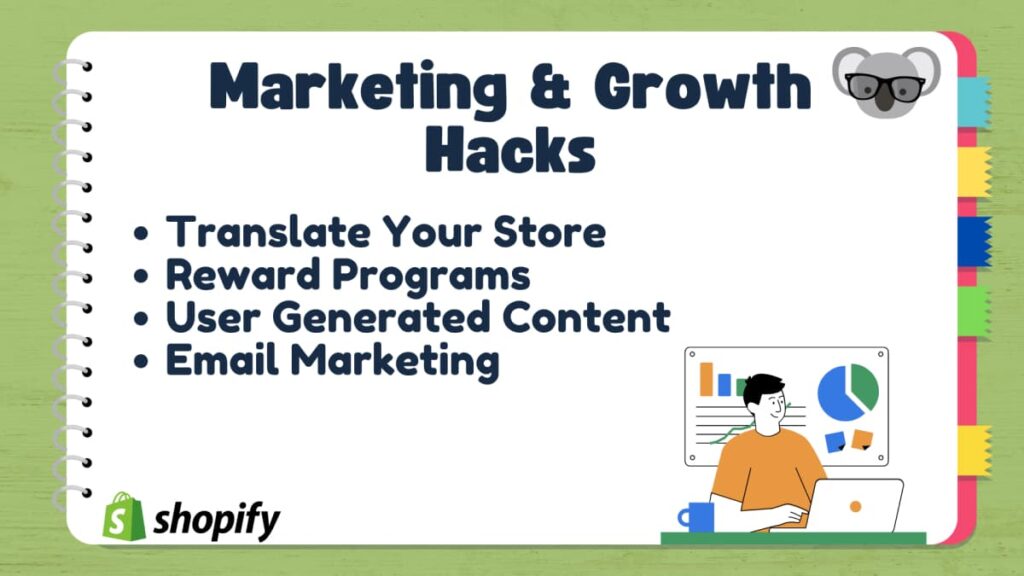
A surefire way to increase revenue is to grow your shop by focusing on marketing and growth. Yes, everyone knows you can buy a Facebook ad for $5 and run it for a week or two, but those campaigns don’t always translate into profit. Luckily, we have a few other ideas.
6. Translate Your Store
Smaller e-commerce stores usually limit their scope to local and national sales only. But when millions of global users can access your Shopify, why not try to sell to them as well?
Research shows that 9 out of 10 international shoppers will not buy a product without a description or reviews in their native tongue. Look at your statistics, see the foreign countries you get traffic from the most, and translate the content into those languages. This way, you can localize your content and optimize the Shopify SEO in multiple languages.
If you’re unsure how to do it, try the free Shopify Translate & Adapt app. It allows you to edit every written section of your website, from product descriptions to meta titles. You can hire a translation service and manually edit the text or use the auto-translate option.
7. Reward Programs
Repeat customers are 60%- 70% more likely to spend money in your store than first-time buyers. By encouraging newcomers to enroll in a loyalty program, you can convert newcomers into loyal clientele. You can set up a tiered system that gives greater rewards the more they purchase. For instance, offer a 35% discount after exceeding $350 in total purchases or a gift with every order over $25 when they reach a total of $600 in purchases.
You can also use loyalty programs to collect customer emails. Motivate them to sign up with their email by offering exclusive discount codes, early notifications about new product launches, and even freebies on their birthdays. Word of mouth is another powerful tool. Encourage your customer base to refer your business to friends and family and offer a set amount off their next purchase for every three referrals. VIP clubs and rewards programs are easy to implement.
The Shopify store has hundreds of apps that do just that, but our recommendations are Smile: Loyalty & Rewards and Rivo: Loyalty & Referrals, known for their effectiveness.
8. Embrace User Generated Content
Who better to show off the quality of your goods than the people who use their own money to buy them? These days, everyone is documenting their life on social media, so it won’t be hard to come across a post or video showcasing the product in action.
Prominently feature these reviews on your product page because there’s no greater selling tool than a genuine reaction from a customer who’s happy with what they bought.
9. Email Marketing
Even with so many advertising options available, email marketing is still going strong and generating $36 for every $1 you spend. Many marketers believe it’s a more effective sales strategy than pay-per-click and social media.
Most email providers seamlessly integrate with Shopify and are easy to use for expert marketers and beginners. Shopify even has an email marketing tool that can help you optimize the process. You can build your email flow by setting up trigger actions that activate the automatic email sequence. Some of these triggers are:
- Send new customers a welcome message offering them a discount, introducing your business, or highlighting your best sellers;
- Send a reminder once or twice a week, offering free shipping or an extra gift to entice them to finish the transaction;
- Send a mail thanking them for their business and recommending similar products;
- Launch a win-back campaign, offering exclusive deals or first pick of limited edition items.
Design & UX Hacks

Most people do judge a book by its cover, and 75% of consumers will decide if they stay or leave a site based on aesthetics. So, take the time to improve your digital storefront because a user interface that’s easy to navigate and looks good can increase conversion rates by 200%.
10. Use a Paid Theme
As much as we love a free theme, the truth is that paid ones have more features and variety. Most free themes don’t give you much freedom to customize them. They also lack extras, so you must install apps or add-ons for a satisfying shopping experience.
Paid themes include useful features like advanced product filtering, wish lists, mega menus, etc. They also have click-and-slide templates, which allow you to customize your site’s visuals fully.
11. Avoid Too Many Apps
While apps and add-ons can add extra features to your Shopify store, having too many will significantly slow down its performance. According to statistics, 40% of visitors will leave a site if it doesn’t load in at least three seconds. Audit which apps you use the least or don’t add value to your operations and remove them to improve performance. Or invest in a paid theme because, as we mentioned before, they already come with most of those functionalities.
12. Optimize Images & Videos
The load speed of a site is also affected by pictures and images. Improperly formatted product pictures and videos will impact speed performance and cause loading issues. A website that takes over 10 seconds to load has a 123% bounce rate and doesn’t rank as high on Google.
To avoid this issue, try to resize or compress the images before uploading them. Depending on its purpose, each image must be uploaded using a specific aspect ratio and file size. Use tools like Shopify’s Simple Image Resizer or TinyIMG, as not all of us are Photoshop experts.
Social Media Hacks

There are 5.07 billion social media users in 2024. If you know how to reach and grab their attention, those are billions of potential clients. Take advantage of the fact that everyone is glued to their phones and get your products in front of their eyes with a few easy tricks.
13. Create a Shoppable Instagram Feed
Instagram has 2 billion users that actively use the platform each month. Over 24.5% of them use Instagram to buy products that show up on their feed. To get a piece of the action, open your Insta, go to settings, click on Account type and tool, and switch to a professional account.
Access settings to activate the shopping feature and link a product’s catalog. Now, you’re free to add clickable tags to your pictures and videos that allow users to shop directly from their feeds.
14. Partner With Influencers
Shopify store owners can grow their business by fostering a strong working relationship with influencers. If you partner with the right online personality to endorse your products, for every $1 you invest, you can expect a minimum ROI of $6.50.
You can start small and offer free products in exchange for posting an honest review that you can later use as promotional material on your page. To broaden the reach, try collaborating with creators on multiple platforms like YouTube, TikTok, and Instagram.
A great example of the results you can achieve with this tactic is the brand Gymshark, which grew into a billion-dollar business with the help of influencer marketing.
Advanced Hacks
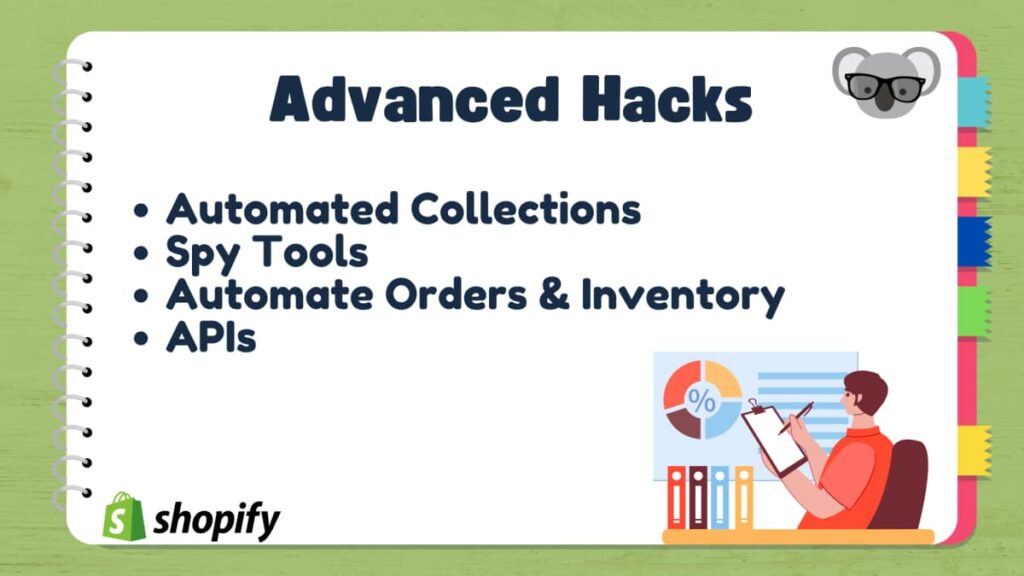
What we covered so far is effective yet basic stuff. Now, it’s time to look at a few advanced strategies that will take your business to the next level and help you streamline operations.
15. Use Automated Collections
If you’re constantly adding new stock, manually sorting it into individual collections takes a lot of time. It’s also possible to leave out a few items, creating so-called “orphaned products” that don’t appear unless buyers specifically search for them. Enabling automated collections takes care of that. Products will be sorted into their respective category automatically based on:
- Type
- Brand
- Color
- Price
- Size
- Material
- Stock
- Any other condition you set up
16. Use a Shopify Spy Tool
You can’t expect to turn a profit if you don’t know which items sell better than others. A “spy” tool like Koala Inspector can provide many interesting insights into what the competition is doing. Take what you learn and use it to improve your store and operations.
Using this tool will give you access to metrics like:
- Discover which items sell like crazy and which are not worth stocking;
- Compare the cost of similar items to see if your price tags are competitive;
- See what themes the top-ranked sellers use and why they attract the most attention.
To learn more about the right tool for your store you can see our list of the best 15 spy tools.
17. Automate Your Order & Inventory Management
Mistakes are inevitable when processing, packing, and shipping. A return due to an incorrect shipping label or the wrong item can cost you up to 66% of the value of that order.
Integrating a fulfillment service with your Shopify will automate the picking and fulfillment process, minimizing human error. This is particularly beneficial if you have a dropshipping store because the orders are sent directly to the fulfillment center, so you don’t have to enter data manually. Shopify has its fulfillment network, while another popular option is FedEx Fulfillment.
18. Shopify APIs
API integrations are pretty advanced stuff, which is why few shop owners use them or know they exist. They’re powerful tools that allow developers to integrate the Shopify platform with third-party applications and systems.
You can use them to add extra functionalities, customize the theme, manage customer data, etc. Shopify has an extensive API library for everything you need.
Some of the most common APIs are the:
- Product Discount API: Automatically apply discounts to select products or orders.
- Payment Customization API: Customize payment options based on location or amount.
Hack Your Way to the Top
There’s no shortage of ways to improve retention rates and skyrocket your Shopify profit. It’s always best to start small and implement the basics, then add on that foundation with the advanced stuff.

